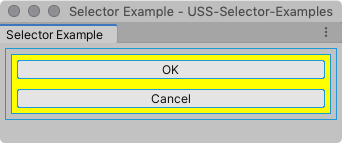Child selectors
USS child selectors match elements that are the child of another element in the visual treeAn object graph, made of lightweight nodes, that holds all the elements in a window or panel. It defines every UI you build with the UI Toolkit.
See in Glossary.
Syntax
A child selector consists of multiple simple selectors separated by >.
selector1 > selector2 {...}
You can include the wildcard selector in complex selectors. For example, the following USS rule uses the wildcard selector in a child selector. This USS rule matches buttons that are children of elements that are children of an element with the USS class yellow assigned to it.
.yellow > * > Button{..}
Note: USS doesn’t support selecting the nth child of elements with the same name. Use class selectors or unique element names instead.
Example
To demonstrate how simple selectors match elements, here is an example UI Document.
<UXML xmlns="UnityEngine.UIElements">
<VisualElement name="container1">
<VisualElement name="container2" class="yellow">
<Button name="OK" class="yellow" text="OK" />
<Button name="Cancel" text="Cancel" />
</VisualElement>
</VisualElement>
</UXML>
With no styles applied, the UI looks like the following:

The following child selector style rule matches only the inner element. Element #OK with the .yellow class is a child of element #container2. #container2 is child of element #container1. However, because #OK is not a direct descendant of #container1, it doesn’t match the .yellow selector when applied with a child selector from #container1.
#container1 > .yellow {
background-color: yellow;
}
The UI looks like the following when you apply the style:
